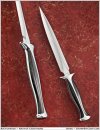- Joined
- Oct 17, 2007
- Messages
- 4,151
Anybody using these things? Looks like jewelers use them for detail polishing, as well as tool and die makers. They’re normally pretty pricey, though the pneumatic import brands are significantly more cost effective. I know you’re probably not gonna want to polish a broad sword with it, but seems like it might be good for folder blades, or smaller details like plunge lines and whatnot.
Thoughts? I may pick one up just to try.
Pneumatic Grinder Ultrasonic Vibration Grinding Polishing Machine Reciprocating File Air Grinder 1/8 Inch https://www.amazon.com/dp/B07CZWM7T2/ref=cm_sw_r_cp_api_fabc_Z9rYFbJFEFZS8
Thoughts? I may pick one up just to try.
Pneumatic Grinder Ultrasonic Vibration Grinding Polishing Machine Reciprocating File Air Grinder 1/8 Inch https://www.amazon.com/dp/B07CZWM7T2/ref=cm_sw_r_cp_api_fabc_Z9rYFbJFEFZS8


